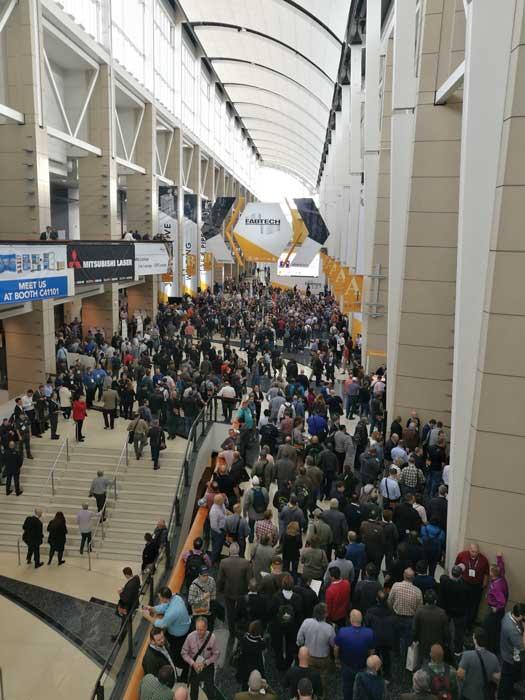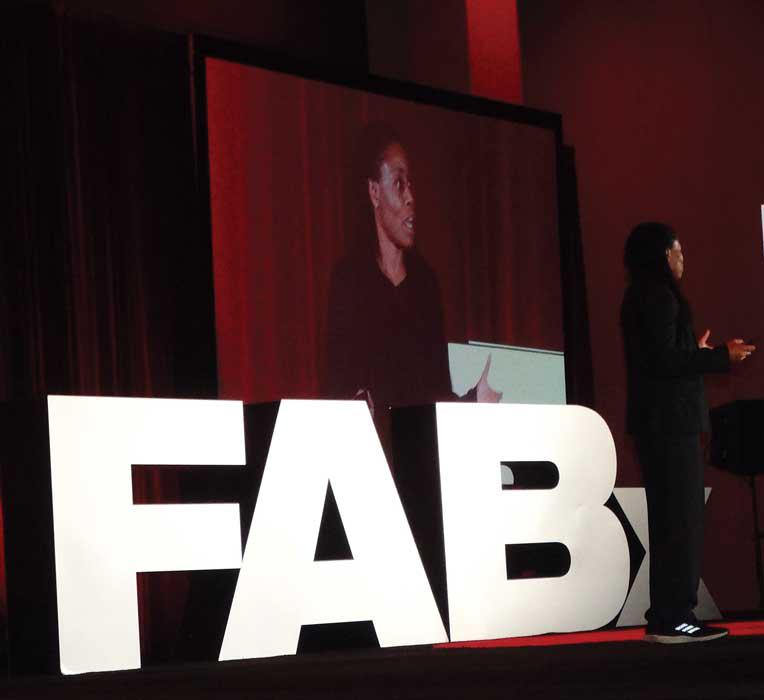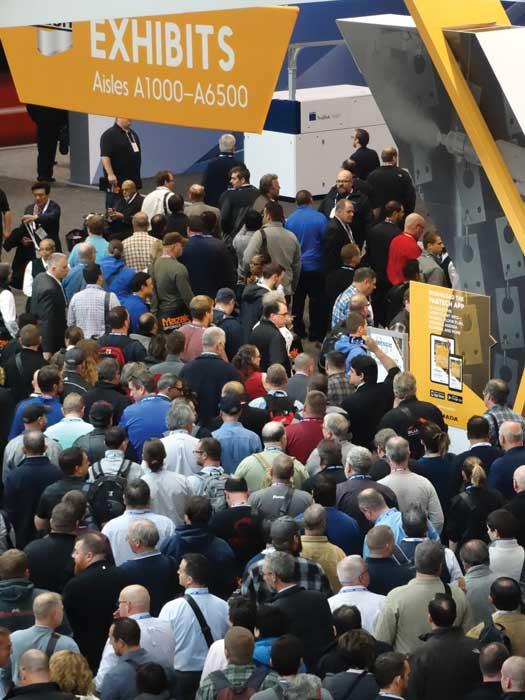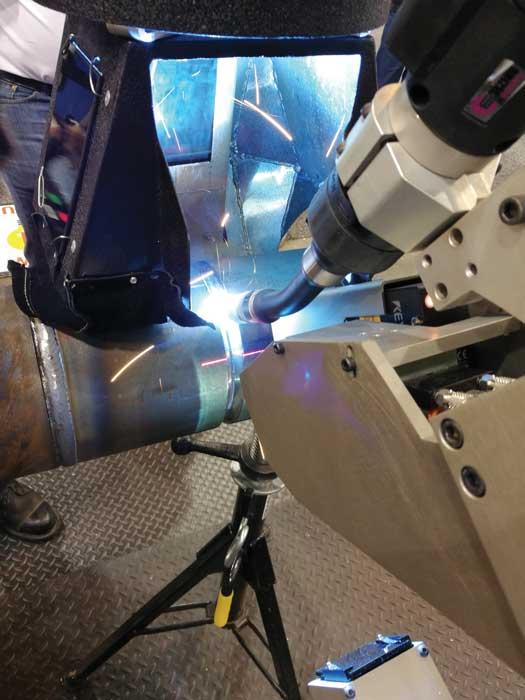Senior Editor
- FMA
- The Fabricator
- FABTECH
- Canadian Metalworking
Categories
- Additive Manufacturing
- Aluminum Welding
- Arc Welding
- Assembly and Joining
- Automation and Robotics
- Bending and Forming
- Consumables
- Cutting and Weld Prep
- Electric Vehicles
- En Español
- Finishing
- Hydroforming
- Laser Cutting
- Laser Welding
- Machining
- Manufacturing Software
- Materials Handling
- Metals/Materials
- Oxyfuel Cutting
- Plasma Cutting
- Power Tools
- Punching and Other Holemaking
- Roll Forming
- Safety
- Sawing
- Shearing
- Shop Management
- Testing and Measuring
- Tube and Pipe Fabrication
- Tube and Pipe Production
- Waterjet Cutting
Industry Directory
Webcasts
Podcasts
FAB 40
Advertise
Subscribe
Account Login
Search
FABTECH previews the future of metal fabrication
Show attendees predict a positive 2018
- By Tim Heston
- January 4, 2018
- Article
- Shop Management
Every FABTECH® reflects the metal fabrication industry’s mood, and in November 2017 the mood was undeniably positive. Almost 45,000 people came to McCormick Place in Chicago Nov. 6-9 to visit 1,700 exhibitors in over 750,000 square feet of exhibit space.
FABTECH attendees usually give a somewhat rosy view of the industry’s overall health. After all, those attending probably work at businesses healthy enough to buy equipment. But more than previous FABTECHs, attendees at the 2017 show had particularly positive outlooks.
“2017 has been a very good year for us,” said Nathan Lindenberg, foreman at The Chism Co., a 20-employee architectural fabricator in San Antonio, Texas. “We’re looking to hire 10 to 12 more people in 2018.” For a 20-person firm, that’s saying something.
“Our growth has been huge,” said Kevin Mann, account manager for R&M Mfg., a stamper and fabricator in Buffalo, Minn., that exhibited at the show. “I would expect us to grow by at least 15 percent next year.”
According to attendee Bryan Boggs, service engineer at Memphis, Tenn.-based Barnhart, big projects are on the move. He should know; Barnhart specializes in fabricating massive material handling systems to move extremely large structures, from 800,000-pound transformers for power companies to large stamping presses for manufacturers. “Things really started to pick up during the third quarter [of 2017],” he said, “and 2018 is looking very positive. We recently helped install one of the largest presses in America in California.”
McCormick Place hosted a growing industry undergoing rapid change. Metal fabricators inch closer to having connected factories, with software streamlining work flows in the office and part flows on the shop floor. This wasn’t the first FABTECH to showcase software and Industry 4.0, but the 2017 event put these technologies front and center. Many also focused on flexible automation, not only at the laser but downstream in bending, welding, and powder coating. More automation is now being designed with high-product-mix manufacturing in mind. All this, of course, requires the right people to manage it—and with record low unemployment in many areas, those people are becoming harder to find.
The topics and technologies discussed at FABTECH 2017 revealed what this industry needs, now and in the future: good people managing technology that not only cuts, bends, and welds faster and better, but helps make the entire process of metal fabrication more efficient.
Keynote Gumbo
The four speakers at FABTECH’s FABx keynote (modeled after the popular TED Talks) gave a concise view of several industry challenges: the connected factory, the need for skilled tradespeople, and the desire for good-paying jobs.
“There are some people and some businesses that are leveraging technology. And for the most part, they’re doing really well. Those businesses who don’t are being leveraged by technology, and it becomes harder to succeed. It is our responsibility to stay on the right side of that leverage equation. In many ways, that’s what this event is all about.”
So said business futurist Patrick Schwerdtfeger, a speaker sponsored by KeyedIn who presented on the digital factory and connected supply chains. “We need to keep our eyes on the fringe, on the proof cases,” he said. “How can we incorporate these concepts into our own businesses?”

The crowds arrive on FABTECH’s opening day. The show filled three halls in McCormick Place, totaling almost 750,000 square feet of exhibit space.
Next up was Jacques Panis, president of Shinola, a Detroit manufacturer. Today the company’s 300 workers—those who once assembled car engines—are assembling the “tiny engines” (as Panis called them) of wristwatches, bicycles, and other products. In 2012 Swiss watchmakers came to the U.S. to train nine people how to build a watch. “Today we now have 300 people making 100,000 watches [a year] in the city of Detroit,” Panis said.
He was careful to point out that people sometimes misunderstand the company’s mission. “People confuse Shinola with an ‘American-made’ play. But at the end of the day, our mission is to create good manufacturing jobs in the city of Detroit.”
Shinola is having a ripple effect. Recently Panis contacted a Wisconsin tube fabricator about making frames and forks for bicycles, most of which had long been outsourced to Taiwan. “We needed frames and forks for 1,000 bicycles, and [the Wisconsin fabricator] said he hadn’t made bicycle frames in more than 20 years. I asked him what he needed. He needed a P.O. and some capital. I gave him a check upfront. What was the next step? He needed to hire people. A business like Shinola not only leads to job creation in a city like Detroit, but it also affects other cities and other communities around the U.S.”
Adam Genei of Detroit’s Mobsteel took the stage next. Since launching the custom car company in 2002, Genei has expanded his shop from a small fabrication job shop to a custom car specialist for entertainers, athletes, and other notables. “We loved cars. They basically fed our family. We saw things take a downturn, and that downturn held on. So we jumped ship, and we figured, if we’re going to be broke, we might as well do something we love doing. We launched Mobsteel and fabricated anything. We were having fun with our friends and family.
“One of the keys to our success is we didn’t measure money,” Genei continued. “The money had disappeared. The work had disappeared. Many of my friends and family had lost their businesses and their jobs. We instead measured everything besides money. Where was I at yesterday, and where am I today? Who did I do business with today, and who am I going to do business with tomorrow? Those relationships build our reputation.”
The next presenter, Karen Kerr, executive managing director of Chicago-based GE Ventures, spoke of the “digital thread” of manufacturing and, specifically, how data and connected factories will create entirely new business models—particularly when it comes to additive manufacturing.
“We were recently selected by Textron Aviation to supply the turbo prop engine for their new Cessna,” she said. “We 3-D printed this engine and were able to take 855 parts and reduce that to a mere 12 parts. Also, the development time for an engine can take many years. We were able to reduce that development time by a third.” More than that, the engine used 20 percent less fuel and produced 10 percent more power.
Kerr spoke of how this and other technology, combined with connected factories among suppliers and OEMs, eventually will push manufacturing to become a far different world than it is today. “The supply chain of the future will be dramatically shortened and very customer-centric.”
Michael Walton, industry solution executive at Microsoft, explained how this current environment has changed the game when it comes to how one defines a successful company. “Speed and agility is key,” he said, adding that without them, large and seemingly powerful industry players can lose their footing and even fail. “In [mergers and acquisitions], it used to be a big fish would eat a small fish. That isn’t the case now. We have very small companies that are eating big fish.”
The presenters spoke for only 10 minutes each, but combined, their content offered a kind of metal fabrication gumbo. They put very different ingredients all in the same bowl, and you need the perfect combination for it to taste just right: good portions of complementary technology (machines and software) enveloped by a roux of good, skilled, engaged workers.

Karen Kerr, executive managing director of GE Ventures, speaks at the FABx keynote, styled after the popular TED Talks, on the first day of the show.
The technology varies depending on what customers demand. A customer ordering a custom car and even a high-end watch is much different than a customer ordering a turbo prop engine. But the need for good people who understand the intricacies of fabrication, from arc welding to bending to additive manufacturing, is the same.
Right Technology, Right Focus
FABTECH’s additive manufacturing (AM) pavilion had a larger presence than ever. More fabricators are gaining interest, and not just in metal AM either.
“We’re now using 3-D printing to help us fixture different parts, especially for shorter runs,” said attendee Sarah Richards, president/CEO of Jones Metal, a custom fabricator in Mankato, Minn. “And we’re now using some custom press brake tools out of 3-D printed polycarbonate material. It’s for short-run, thin-gauge [low-tonnage] jobs. Tooling with a 3-D printer is $300 versus $3,000 [for a traditional custom brake tool].”
She added that thinking like this helps fabricators overcome some of the industry’s principal challenges. “The challenge in the industry is that lead times are getting shorter and shorter,” she said. “You have to be the first and the best, and you don’t necessarily have to be the cheapest, but you also need to be price-conscious.”
Today fabricators have many alternatives when it comes to technologies. At the show, suppliers of high-density plasma cutting systems showcased the clean edges those systems are now able to create. Most fiber laser cutting systems—which now make up the majority of new laser cutting machine sales—have been able to outpace material handling automation, so machine makers have been enhancing the material handling automation to keep pace.
They’ve also sped up bending and made it more flexible. This includes press brakes with automated tool changes and robots that can be swapped out so a brake can change over quickly between full automation and manual operation.
According to the “2018 Capital Spending Forecast,” published by the Fabricators & Manufacturers Association Intl. and released at the show, projected spending on hydraulic press brakes, electric press brakes, and other forming equipment like panel benders and folders is approaching $400 million, more than twice the projected spending on fiber lasers. That’s significant, considering what a fiber laser costs compared to a press brake. It also points to increased investment in high-end bending machines and automation.
Still, implementing automation in low-volume, high-product-mix operations (like custom fabricators) has its challenges. Getting robots to adapt to such changes hasn’t always been easy.
Industry has taken several approaches to overcome this issue, and all were on display at the show. Robot installations now can be simulated offline using virtual and augmented reality. Programs can be written and simulated offline. The nature of the robot has changed as well, and it’s here that collaborative robots—those that don’t need traditional robotic safeguarding and can react to the world around them—step into the picture.
Although collaborative robots didn’t dominate the FABTECH exhibit floor, their presence greatly increased from previous shows. Collaborative robot arms could be seen at several booths. Novarc Technologies (www.novarctech.com) featured its collaborative robot for pipe welding. And robotics integrator Ready Robotics (www.ready-robotics.com), which also allows companies to “hire” robotic systems on an as-needed basis, showed projects in which collaborative robots tended ironworkers and press brakes. Meanwhile, Universal Robots (UR) (www.universal-robots.com) and Arc Specialties (www.arcspecialties.com) have collaborated on a welding system using a UR arm. Welders can program the robot by physically moving the robot arm from one reference point to another and using a tablet interface. Alternatively, the robot can be programmed offline.
The idea is to move automation where it’s needed, adapting to a changing product mix. Have a large order that calls for a lot of simple brackets? A brake operator can set up a collaborative robot by the press brake, stage blanks, program it, then move on to an adjacent press brake where he can form the more complicated components. The same could be said for welding, with the collaborative robots working on simpler parts while the skilled workers concentrate on the complicated weldments.
Madison, Ala.-based Matsumoto U.S. Technologies (www.matsumotous.com) gave a hint as to what such high-end manual welding could look like in the future. Within a laser-safe enclosure, the company demonstrated its hand-held laser welding technology that uses a pulsed fiber laser to weld stainless, titanium, and other materials. The system can be used with laser-safe glasses with sensors; if the glasses should slip a small amount, the laser shuts off. Similarly, if the laser head itself is pulled away from the workpiece, the system shuts off immediately. While Matsumoto can exhibit the technology at tradeshows, the company is awaiting FDA approval to sell it in the U.S. The company’s system has been in use in Japan for about five years.
Fabricator of the Future
Walking the halls of FABTECH 2017, attendees could see myriad companies touting the benefits of Big Data. Software is beginning to touch every aspect of metal fabrication, from the moment an order comes in the door until the last product is shipped. Many of the major sheet metal fabrication and welding players had flat screens in their booths showing quality and uptime data. With the right systems in place, any shop manager with a phone can pretty much tell where things stand.
Front-office operations are becoming more automated too. Consider the following situation, as described by Raj Reddy of OmegaCube Technologies (www.omegacube.com), Itasca, Ill. Customers send in drawings, software nests the job and simulates the bending. A few clicks later, the remaining operations are estimated and quoted, then sent back to the customer. Once the order comes in, the drawing, bills of material, and routing information are exported to the ERP, and scheduling occurs automatically based on set rules and machine load levels. And the schedule can be constantly updated as load levels change. “The scheduling happens continuously, and you can set up how frequently you need to reschedule,” he said.
Considering this, it seems as if industry is well on its way toward Industry 4.0. But as sources at the show pointed out, it’s really not that simple. As Reddy put it, “Machines still need to be maintained. People need to be engaged. It’s not just about what software can do. It’s what business owners visualize it can be. That’s what drives it at the end.”
“Has anyone had this happen? Your boss says, ‘You’re the Industry 4.0 guy. Here’s your budget. Do Industry 4.0 to our factory.’” So said Will Healy, marketing management director of Balluff, Florence, Ky., during a conference session on the smart factory. “I’ve met people who tell me stories like this. They’re just one person, and companies haven’t even identified the problem they’re trying to solve. You can put mountains of data on a server somewhere. But if you don’t know what your problem is, you’re just wasting your time.”Such “smart” technology needs a business case; it needs to solve an operational problem or help a fabricator better meet customer demands. And customer demands are, of course, extraordinarily diverse. Mobsteel’s customer base isn’t like the OEM customer base of a custom fabricator, or like the customers of GE’s aviation business.
James Mosman, associate professor of welding technology at Odessa College, Odessa, Texas, gave his perspective on the show. His school is witnessing the resurgence of oil and gas work in the Permian Basin. Once again, the industry can’t find enough welders to meet demand. He spent a lot of time in the additive manufacturing pavilion. (3-D metal printing can be considered a kind of welding process, after all.) He also perused the welding hall, full of software and electronics aimed at improving welding performance.
“We can no longer just train ‘welders’ or ‘machinists’ or ‘fabricators.’ We all have to start working together,” he said. Mosman then followed up with a comment that summed up one of FABTECH 2017’s major themes: “You have computers in your welding machines, computers running your fabrication machines, and you can see and control everything from your phone. We all need to look at the big picture and think, ‘Where are we going to be in five or 10 years?’”FABTECH® is sponsored by the Fabricators & Manufacturers Association Intl., SME, the American Welding Society, the Precision Metalforming Association, and the Chemical Coaters Association Intl. The next FABTECH will occur Nov. 6-8 at the Georgia World Congress Center in Atlanta. For more information, visit www.fabtechexpo.com.
About the Author

Tim Heston
2135 Point Blvd
Elgin, IL 60123
815-381-1314
Tim Heston, The Fabricator's senior editor, has covered the metal fabrication industry since 1998, starting his career at the American Welding Society's Welding Journal. Since then he has covered the full range of metal fabrication processes, from stamping, bending, and cutting to grinding and polishing. He joined The Fabricator's staff in October 2007.
Related Companies
subscribe now

The Fabricator is North America's leading magazine for the metal forming and fabricating industry. The magazine delivers the news, technical articles, and case histories that enable fabricators to do their jobs more efficiently. The Fabricator has served the industry since 1970.
start your free subscription- Stay connected from anywhere

Easily access valuable industry resources now with full access to the digital edition of The Fabricator.

Easily access valuable industry resources now with full access to the digital edition of The Welder.

Easily access valuable industry resources now with full access to the digital edition of The Tube and Pipe Journal.
- Podcasting
- Podcast:
- The Fabricator Podcast
- Published:
- 04/16/2024
- Running Time:
- 63:29
In this episode of The Fabricator Podcast, Caleb Chamberlain, co-founder and CEO of OSH Cut, discusses his company’s...
- Trending Articles
Capturing, recording equipment inspection data for FMEA

Tips for creating sheet metal tubes with perforations

Are two heads better than one in fiber laser cutting?

Supporting the metal fabricating industry through FMA

Omco Solar opens second Alabama manufacturing facility

- Industry Events
16th Annual Safety Conference
- April 30 - May 1, 2024
- Elgin,
Pipe and Tube Conference
- May 21 - 22, 2024
- Omaha, NE
World-Class Roll Forming Workshop
- June 5 - 6, 2024
- Louisville, KY
Advanced Laser Application Workshop
- June 25 - 27, 2024
- Novi, MI





























